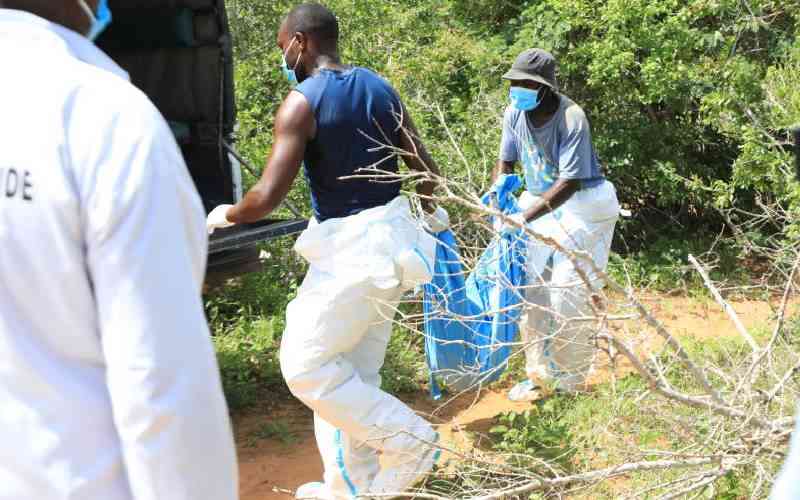By JOE KIARIE
As the sun sets on the vast savannah that characterises Ilkeek-Lemedung’i Village in Kitengela, Kajiado County, a Maasai moran keenly watches over hundreds of livestock from atop a molehill.
With a pocket radio tightly pinned to one ear and six dogs panting at his feet, Mr Saitoti Letevesi knows so well that he cannot afford to wink one too many times. Events from the previous night explain why.
At 10.30pm last Tuesday, he came face to face with a pride of four lionesses as he walked home. Convinced he had dodged them by calmly engaging the reverse gear, he would moments later be stopped in his tracks by the roaring of a lone male lion roaming the grasslands only a stone throw away from his house.
With barely 24 hours gone, he is thus well aware that the lions could be lurking in the nearby bushes, reading his every move waiting to pounce on the treasured yet vulnerable cows, sheep and goats.
To most people, Letevesi’s plight could easily pass as a script from an unnerving jungle movie. But to the pastoralist community in Kitengela, this is the reality they have to contend with for the better part of the calendar.
Here, attacks on sheep by the marauding wild cats no longer make news and the locals have to spend sleepless nights if they are to save their livestock from the mighty jaws of the jungle kings.
Pass as a script
It is in this same village that morans speared to death six lions, among them two cubs, which were feasting on sheep in one of the bomas (homesteads) barely a week ago. But Letevesi claims the current attack spree by lions is bewildering as the cats have been daringly invading cowsheds and feasting on livestock for hours in the past few weeks.
“Mimi sijawahi ona hivi. Hawa simba hawaogopi. (I have never seen this. These lions are fearless,” he exclaims.
Miles away in Olosirkon Village adjacent to the Nairobi National Park (NNP), similar battles between men and carnivores persist. An elderly Mzee Muneenge ole Keeja recounts how he had to boldly accost a lion that had pounced on his bull at midday last Tuesday.
“I was watching over the cows when I suddenly noted a male lion trying to isolate a bull. But it stopped after I ran shouting and threw my club at it,” notes ole Keeja, whose livestock grazes alongside hundreds of wild animals such as zebras, antelopes, wildebeests and ostriches.
Simon Olopii, a resident who grazes on the plains daily explains this is not a new occurrence as lions and other wild carnivores have always pounced on their wildlife. “After a rainy season, the natural prey such as zebras and antelopes run away from the lions in the park and come to this side.
The lions follow them across Empakasi River. But because the wild herbivores are not easy to catch, the lions mostly kill the sheep. They mostly attack in the bomas between 1am and 2am and occasionally during the day,” he says.
Olopii says crocodiles; baboons and hyenas have equally been a menace over the years. “The crocodiles usually attack the livestock as they take water in River Empakassi.
The baboons snatch and eat lambs while hyenas follow the lions to the bomas, snatch young sheep and take off,” he says. But the herdsman notes that while the Maasai community respects and peacefully co-exists with wild animals, it is a rule that every lion that feeds on a cow outside the park must die. “We are never compensated yet each cow can fetch us about Sh50,000. The rule thus is that if a lion kills a cow we kill it. We will eliminate all of them if no action is taken to keep them off our livestock,” he says.
Stay informed. Subscribe to our newsletter
His sentiments are expressively echoed by Mzee ole Keeja. Olopii laments that game wardens usually hunt down herdsmen cruelly if they graze in the park during the dry season and says intrusive beasts should neither be allowed on their side.
William ole Ntutu admits lions have in the past always feared human beings and predominantly fed on livestock that strayed but says the carnivores have from early this year showed rare audacity. “They no longer fear people, lamps and even floodlights and are breaking into bomas at will. Their numbers have also significantly gone up,” he states. Back in Ilkeek-Lemedung’i Village, every villager we talk to has a tale to tell about the havoc the lions have been wreaking.
As he pensively sits outside his abode, Simon ole Pita, who is relatively new in the area, says a lone lion passes by their farm daily, while a pair of lionesses occasionally roams in the area. On June 20, he narrates how the lone male mauled a sheep in the farm. Three days later, he says it killed his neighbour’s sheep before rushing to their homestead after it was chased away.
“We woke up after the dogs howled fiercely and found it had already jumped over the mesh wire fence and was trying to gain access to the cowshed. But it jumped over after it was surrounded by nine dogs and saw a torch,” ole Pita states, holding onto the hide of the dead sheep.
Apparently, well-fed packs of dogs are a conspicuous feature in every homestead here and we learn that they play a major role in alerting their owners when wild carnivores approach.
In Fred King’ang’ir’s homestead, where the six lions were killed on June 20, an elderly woman who seeks anonymity is still lost for words to explain the chilling episode.
“Simba sita walilala hapa kwa boma wakikula mbuzi yangu. Mimi sijawahi sikia hiyo na mimi bado amini. (Six lions spent the night hear feasting on my goats.
Pierced to death
That is unheard of and I am yet to believe it,” she says, explaining how she has to light bonfires daily to keep off the cats. She notes the long grass has made it easy for the lions to hide near homesteads.
We learn the six lions were apparently blinded using vehicle floodlights from all angles before they were pierced to death by tens of morans. Interestingly, two lions that survived the moran massacre went back to the village the following day and allegedly killed eight livestock. At the local Oloika Primary School, one teacher says the lion menace is yet to affect studies but all pupils are sternly ordered to be indoors by 6pm.
Dr Laurence Frank, the Director of Living With Lions notes his organisation had contacted the Kenya Wildlife Service (KWS) two months before the lions were killed warning the cats posed a serious danger even to human beings.
“We said it was dangerous to have lions that do not fear people living in a residential area, and offered to help KWS trap them and return them to the park. In the end, KWS captured them without our assistance,” he notes.
Frank notes that although lions were nearly eradicated from the park by morans 10 years ago, they have recovered well and there may actually now be more lions than the park can support.
“We badly need a good study of the NNP lions: how many there are, what they are feeding on, and where they move when they leave the park,” the director told The Standard On Saturday.
 The Standard Group Plc is a
multi-media organization with investments in media platforms spanning newspaper
print operations, television, radio broadcasting, digital and online services. The
Standard Group is recognized as a leading multi-media house in Kenya with a key
influence in matters of national and international interest.
The Standard Group Plc is a
multi-media organization with investments in media platforms spanning newspaper
print operations, television, radio broadcasting, digital and online services. The
Standard Group is recognized as a leading multi-media house in Kenya with a key
influence in matters of national and international interest.
 The Standard Group Plc is a
multi-media organization with investments in media platforms spanning newspaper
print operations, television, radio broadcasting, digital and online services. The
Standard Group is recognized as a leading multi-media house in Kenya with a key
influence in matters of national and international interest.
The Standard Group Plc is a
multi-media organization with investments in media platforms spanning newspaper
print operations, television, radio broadcasting, digital and online services. The
Standard Group is recognized as a leading multi-media house in Kenya with a key
influence in matters of national and international interest.









